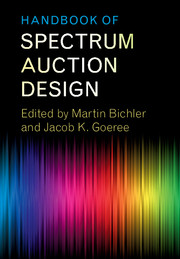Book contents
- Frontmatter
- Contents
- List of Contributors
- Preface
- List of Papers
- Part I The Simultaneous Multiple-Round Auction
- Part II The Combinatorial Clock Auction Designs
- 5 Combinatorial Auction Design
- 6 The Clock-Proxy Auction: A Practical Combinatorial Auction Design
- 7 Spectrum Auction Design
- 8 A Practical Guide to the Combinatorial Clock Auction
- 9 Market Design and the Evolution of the Combinatorial Clock Auction
- 10 Quadratic Core-Selecting Payment Rules for Combinatorial Auctions
- 11 Core-Selecting Package Auctions
- 12 A New Payment Rule for Core-Selecting Package Auctions
- 13 On the Impossibility of Core-Selecting Auctions
- 14 Ascending Combinatorial Auctions with Risk Averse Bidders
- 15 Properties of the Combinatorial Clock Auction
- 16 Budget Constraints in Combinatorial Clock Auctions
- 17 (Un)expected Bidder Behavior in Spectrum Auctions: About Inconsistent Bidding and its Impact on Efficiency in the Combinatorial Clock Auction
- Part III Alternative Auction Designs
- Part IV Experimental Comparisons of Auction Designs
- Part V The Bidders’ Perspective
- Part VI Secondary Markets and Exchanges
- Outlook
- References
6 - The Clock-Proxy Auction: A Practical Combinatorial Auction Design
from Part II - The Combinatorial Clock Auction Designs
Published online by Cambridge University Press: 26 October 2017
- Frontmatter
- Contents
- List of Contributors
- Preface
- List of Papers
- Part I The Simultaneous Multiple-Round Auction
- Part II The Combinatorial Clock Auction Designs
- 5 Combinatorial Auction Design
- 6 The Clock-Proxy Auction: A Practical Combinatorial Auction Design
- 7 Spectrum Auction Design
- 8 A Practical Guide to the Combinatorial Clock Auction
- 9 Market Design and the Evolution of the Combinatorial Clock Auction
- 10 Quadratic Core-Selecting Payment Rules for Combinatorial Auctions
- 11 Core-Selecting Package Auctions
- 12 A New Payment Rule for Core-Selecting Package Auctions
- 13 On the Impossibility of Core-Selecting Auctions
- 14 Ascending Combinatorial Auctions with Risk Averse Bidders
- 15 Properties of the Combinatorial Clock Auction
- 16 Budget Constraints in Combinatorial Clock Auctions
- 17 (Un)expected Bidder Behavior in Spectrum Auctions: About Inconsistent Bidding and its Impact on Efficiency in the Combinatorial Clock Auction
- Part III Alternative Auction Designs
- Part IV Experimental Comparisons of Auction Designs
- Part V The Bidders’ Perspective
- Part VI Secondary Markets and Exchanges
- Outlook
- References
Summary
Introduction
In this chapter we propose a method for auctioning many related items. A typical application is a spectrum sale in which different bidders combine licenses in different ways. Some pairs of licenses may be substitutes and others may be complements. Indeed, a given pair of licenses may be substitutes for one bidder but complements for another, and may change between substitutes and complements for a single bidder as the prices of the other licenses vary. Our proposed method combines two auction formats—the clock auction and the proxy auction—to produce a hybrid with the benefits of both.
The clock auction is an iterative auction procedure in which the auctioneer announces prices, one for each of the items being sold. The bidders then indicate the quantities of each item desired at the current prices. Prices for items with excess demand then increase, and the bidders again express quantities at the new prices. This process is repeated until there are no items with excess demand.
The ascending proxy auction is a particular package bidding procedure with desirable properties (see Ausubel and Milgrom 2002, 2006). The bidders report values to their respective proxy agents. The proxy agents iteratively submit package bids on behalf of the bidders, selecting the best profit opportunity for a bidder given the bidder's inputted values. The auctioneer then selects the provisionally winning bids that maximize revenues. This process continues until the proxy agents have no new bids to submit.
The clock-proxy auction is a hybrid auction format that begins with a clock phase and ends with a final proxy round. First, bidders directly submit bids in a clock auction, until there is no excess demand for any item. Then bidders have a single opportunity to input proxy values. The proxy round concludes the auction. All bids are kept live throughout the auction. There are no bid withdrawals. The bids of a particular bidder are mutually exclusive. There is an activity rule throughout the clock phase and between the clock phase and the proxy round.
- Type
- Chapter
- Information
- Handbook of Spectrum Auction Design , pp. 120 - 140Publisher: Cambridge University PressPrint publication year: 2017
References
- 10
- Cited by



